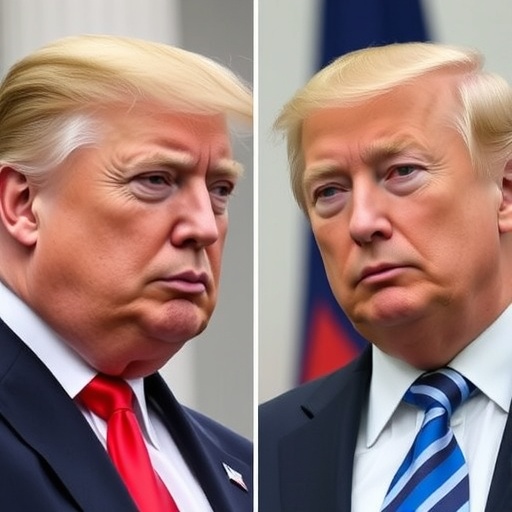Trump Hits Russia with Harsh New Sanctions on Oil Sector to Force End to Ukraine Invasion
In a bold escalation of economic warfare, President Donald Trump announced sweeping new sanctions targeting Russia’s vital oil industry on Tuesday, aiming to squeeze Vladimir Putin’s war machine and compel an end to the ongoing invasion of Ukraine. The measures, which hit major state-owned energy giants like Rosneft and Gazprom, represent Trump‘s most aggressive move yet against Russia since the conflict erupted nearly three years ago, signaling a renewed push for decisive action amid stalled diplomatic efforts.
- Zeroing In on Rosneft and Gazprom: The Core Targets of Trump’s Sanctions Blitz
- Putin’s Kremlin Fires Back: Defiance and Diversion Tactics Against U.S. Pressure
- Ukraine’s Battlefront Boost: How Sanctions Could Tip the Scales in the War Zone
- Global Ripples: Oil Prices Spike and Allies Scramble in Wake of Trump’s Move
- Looking Ahead: Enforcement Challenges and the Road to Potential De-Escalation
The announcement came during a White House press briefing, where Trump declared, “These sanctions will drain the blood from Putin’s coffers. Russia can’t fund its aggression in Ukraine without oil money, and we’re cutting it off.” This comes as U.S. intelligence reports indicate Russian forces have intensified assaults on Ukrainian cities, with over 500,000 troops deployed along the front lines, according to Pentagon estimates. While the sanctions are poised to disrupt billions in revenue, experts caution they may not immediately alter Moscow’s battlefield tactics, given Russia’s pivot to alternative markets like China and India.
Zeroing In on Rosneft and Gazprom: The Core Targets of Trump’s Sanctions Blitz
The heart of Trump’s new sanctions package lies in its precision strikes against Russia‘s energy behemoths. Rosneft, the world’s largest publicly traded oil company by proven reserves, faces immediate asset freezes in the U.S. and a ban on any transactions involving American financial institutions. This effectively severs Rosneft’s access to Western technology and markets, where it previously exported up to 20% of its crude. Gazprom, the natural gas monopoly that powers much of Europe, is hit with secondary sanctions, penalizing any foreign entity that does business with it post-implementation.
According to data from the International Energy Agency (IEA), Russia‘s oil exports generated approximately $180 billion in 2023 alone, funding about 40% of its federal budget and, by extension, its military operations in Ukraine. Trump’s executive order, signed under the authority of the International Emergency Economic Powers Act, expands on previous measures by including joint ventures and even smaller refineries tied to these giants. “This isn’t just about oil; it’s about starving the beast that Putin has unleashed on Ukraine,” said Treasury Secretary Janet Yellen in a statement, emphasizing the sanctions‘ role in disrupting supply chains.
To illustrate the scope, consider Rosneft’s Vankor oil field in Siberia, one of the largest in Russia, which produces over 400,000 barrels per day. U.S. firms like ExxonMobil, previously partnered there, were already ousted in 2022, but now even indirect dealings—such as insurance or shipping—could trigger penalties. Economists at the Brookings Institution project a potential 15-20% drop in Russia‘s oil revenues within the first quarter, though black-market adaptations might mitigate some losses.
Putin’s Kremlin Fires Back: Defiance and Diversion Tactics Against U.S. Pressure
Russia‘s response was swift and unyielding. Kremlin spokesperson Dmitry Peskov labeled the sanctions as “economic terrorism” during a Moscow press conference, vowing that Russia would not bow to Western coercion. “These moves by Trump only strengthen our resolve to defend our interests in Ukraine,” Peskov stated, echoing Putin’s narrative of the conflict as a defensive operation against NATO expansion.
Behind the rhetoric, Russia has been preparing for such escalations. Since the invasion began in February 2022, Moscow has redirected oil flows eastward, with exports to China surging by 25% to over 2 million barrels per day last year, per OPEC figures. India has also emerged as a key buyer, purchasing discounted Russian crude at $10-15 below Brent benchmarks. Putin has invested heavily in the “shadow fleet”—a network of aging tankers evading Western tracking—to bypass sanctions, with over 600 such vessels now in operation, according to Lloyd’s List intelligence.
Yet, cracks are showing. Inflation in Russia hit 8.5% in late 2023, partly due to prior sanctions, and the ruble has fluctuated wildly against the dollar. Analysts from the Atlantic Council warn that Trump’s latest salvo could exacerbate these pressures, potentially forcing Putin to ration military spending. In a rare admission, Russian Central Bank Governor Elvira Nabiullina noted in a recent interview that “external shocks” like these sanctions pose risks to economic stability, hinting at contingency plans involving gold reserves and cryptocurrency trades.
Ukraine’s Battlefront Boost: How Sanctions Could Tip the Scales in the War Zone
On the ground in Ukraine, the news of Trump’s sanctions has injected a dose of optimism amid grueling attrition. Ukrainian President Volodymyr Zelenskyy, speaking from Kyiv, praised the move as “a vital lifeline,” stating, “Every dollar denied to Putin is a bullet and a drone we don’t have to face.” Since Russia‘s full-scale invasion, Ukraine has suffered devastating losses, with the United Nations reporting over 10,000 civilian deaths and the displacement of 6 million people.
The sanctions target not just revenue but logistics. Russian oil revenues have financed the production of Iranian-supplied drones and North Korean artillery shells, which have bombarded Ukrainian positions relentlessly. A recent Ukrainian military assessment estimates that Russia spends $300 million daily on its Ukraine campaign, much of it oil-funded. By curbing this flow, Trump’s policy could delay reinforcements, giving Ukraine breathing room to fortify defenses in Donetsk and Kharkiv oblasts.
However, the impact won’t be instantaneous. Russia maintains stockpiles of refined products sufficient for several months, and its alliance with BRICS nations provides workaround avenues. Ukrainian officials, drawing from experience with earlier sanctions rounds, are coordinating with NATO allies to monitor enforcement. “We’ve seen Russia adapt before, but this pressure from Trump builds on our resilience,” said Defense Minister Rustem Umerov, highlighting joint U.S.-Ukraine intelligence operations tracking sanction evasion.
- Key Ukrainian Gains: Recent counteroffensives have reclaimed 1,200 square kilometers since summer 2023.
- Russian Losses: Over 350,000 casualties reported by Western sources.
- Sanctions Timeline: Full implementation within 90 days, with interim reporting required from U.S. banks.
Global Ripples: Oil Prices Spike and Allies Scramble in Wake of Trump’s Move
Beyond the Russia–Ukraine theater, Trump’s sanctions are sending shockwaves through global markets. Brent crude futures jumped 5% to $85 per barrel immediately after the announcement, reflecting fears of supply disruptions. Energy analysts at Goldman Sachs forecast a potential $10-15 premium if Russia‘s exports drop by 1 million barrels per day, which could add $0.50 to U.S. gasoline prices by spring.
European allies, heavily reliant on non-Russian energy since the 2022 sanctions, expressed mixed support. German Chancellor Olaf Scholz welcomed the pressure on Putin but urged caution to avoid inflating Europe’s energy costs, which remain 20% above pre-war levels. The European Union, which has imposed 14 sanction packages on Russia to date, plans to align with Trump’s measures by targeting additional entities in its upcoming round.
In Asia, China’s Foreign Ministry called the sanctions “unilateral bullying,” while quietly boosting purchases of discounted Russian oil. India’s External Affairs Minister S. Jaishankar defended ongoing trade, noting it helps stabilize global prices. Domestically, U.S. Republicans like Senate Minority Leader Mitch McConnell lauded Trump‘s “America First” approach to countering Russia, while Democrats pushed for broader humanitarian aid to Ukraine.
Environmental groups, such as Greenpeace, highlighted an ironic upside: reduced Russian drilling could cut global emissions by 50 million tons annually if sustained, though they criticized the sanctions for potentially accelerating coal use in Russia.
Looking Ahead: Enforcement Challenges and the Road to Potential De-Escalation
As Trump’s sanctions take effect, the focus shifts to enforcement and long-term strategy. The U.S. Treasury’s Office of Foreign Assets Control (OFAC) will ramp up audits, with fines for violations reaching up to $1 million per incident, as seen in past cases against Russia-linked firms. International cooperation is key; G7 nations have committed $50 billion in additional support for Ukraine, partly funded by frozen Russian assets worth $300 billion.
Diplomatic channels, though frosty, may see tentative openings. Backchannel talks via Turkey have discussed grain corridor extensions, and Trump’s envoy, Keith Kellogg, hinted at “off-ramps” if Putin withdraws from occupied territories in Ukraine. However, with Russian elections looming in 2024, Putin shows no signs of retreat, potentially prolonging the stalemate.
Economists predict that sustained sanctions could shave 2-3% off Russia‘s GDP by 2025, per IMF models, pressuring internal dissent. For Ukraine, bolstering air defenses and reconstruction—estimated at $486 billion by the World Bank—will be crucial. Trump’s gamble underscores a high-stakes bet: that economic pain will eventually outweigh military gains for Russia, paving the way for peace negotiations. As the world watches, the true test lies in whether these sanctions can indeed bend the arc of the Ukraine conflict toward resolution.
In the coming weeks, monitoring bodies like the IEA and UN will track compliance, while Trump administration officials prepare for congressional hearings on expanding the measures. The path forward remains uncertain, but one thing is clear: the economic battle against Russia‘s aggression in Ukraine has entered a critical new phase.









